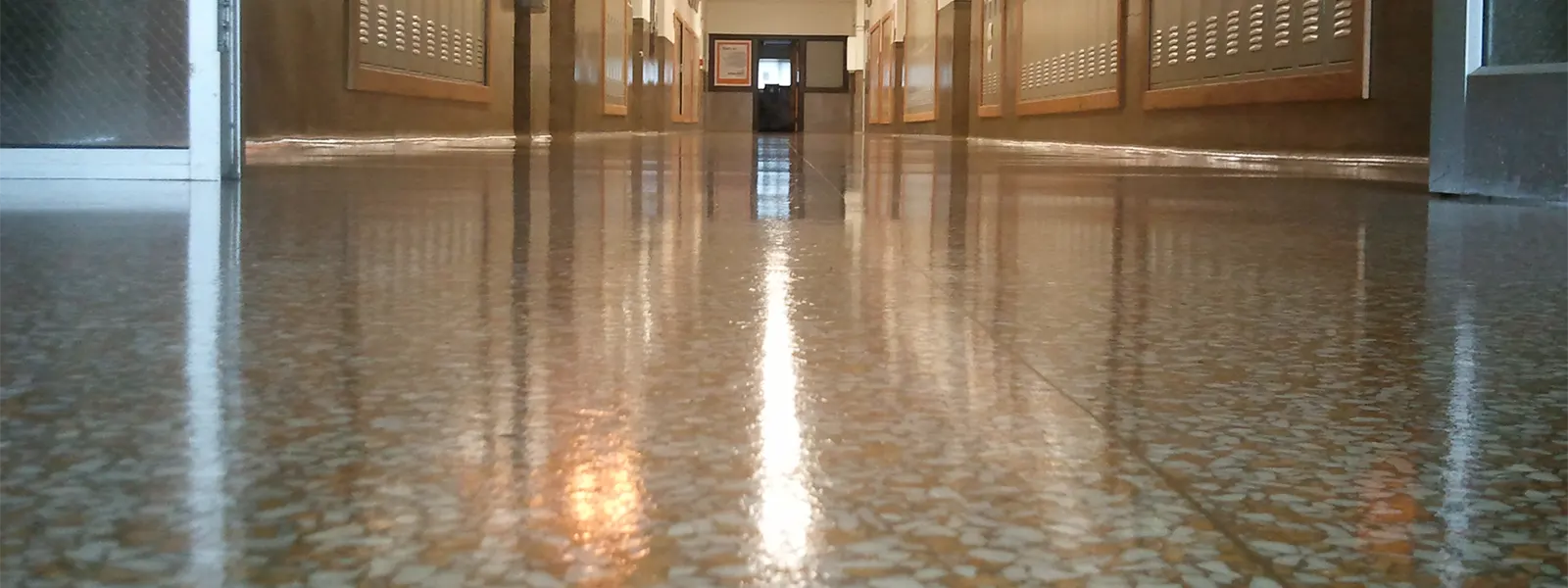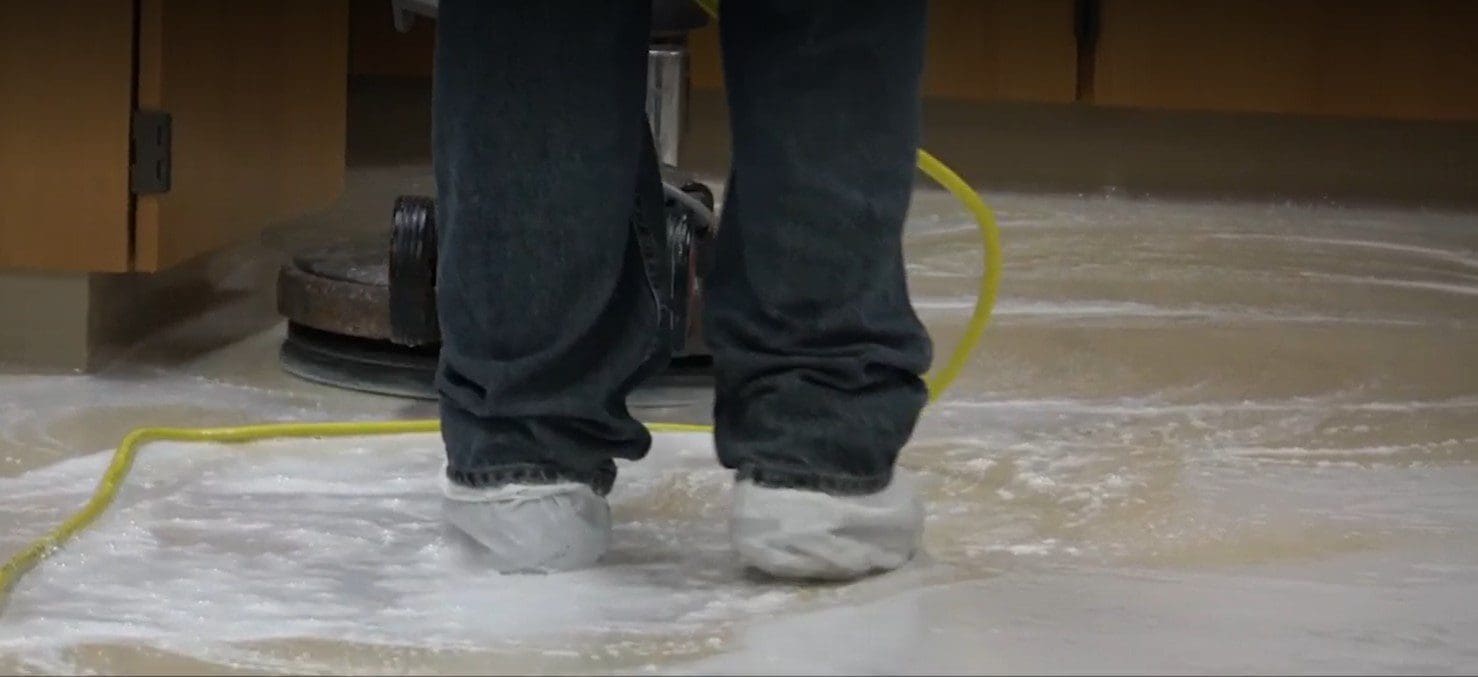Maintaining Terrazzo Floors

If you have terrazzo flooring or are considering having some installed, it’s crucial to know your options to protect your investment for the long term. Like any floor, terrazzo requires maintenance.
What is the best way to maintain terrazzo? The amount and type of terrazzo floor care will depend on how you choose to protect the surface. There are three distinct maintenance approaches to consider:
- covering the floor with an acrylic wax finish,
- grinding and polishing the bare surface to a smooth shine, or
- coating with a water-based thin-film urethane.
Discover how to protect your terrazzo flooring investment for the long term with Ultra Durable Technologies.
What is Terrazzo
People have mixed small chips of marble, quartz, granite, glass, or other materials into a binding substance to create paths, floors, and walls since ancient times. Craftsmen developed cementitious terrazzo in 18th-century Italy by embedding chips into a cement base, then grinding and polishing it, giving terrazzo its name. In the 1970s, innovators introduced another type of terrazzo using a polymer binder (now usually epoxy) instead of cement. Epoxy-based terrazzo allows architects and interior designers to create highly customized, colorful designs, giving them full control over the flooring system’s appearance.
Check out some additional resources on caring for terrazzo here.
Although terrazzo offers great durability, wear and tear over time can affect it. As outlined below, specialists have developed several practices to maintain it.
Acrylic Wax Application
People commonly apply an acrylic wax finish to protect the terrazzo and enhance its appearance. Acrylic finishes wear down quickly, so workers need to buff, recoat, and strip (remove the old wax and apply several fresh layers) frequently. If people neglect this routine, regular traffic dulls the wax and can cause it to turn yellow. Eventually, the wax can wear off completely, exposing the terrazzo to harsh elements.
Grind & Polish
As an alternative, modern grinding equipment can create a polished surface without applying a coating. Polishing increases the shine and clarity of terrazzo while helping you avoid the frequent upkeep required by acrylic wax.
However, grinding and polishing can cost a lot. Additionally, you must maintain the floor regularly using diamond pads. Finally, without a protective finish, stains, etching, and other damage affect the exposed terrazzo more easily.
Water-Based Urethane Coating
A more recent development in maintenance uses thin-film urethane coatings. These coatings offer the best of both worlds: they require much less maintenance than acrylic, provide a strong protective barrier against staining and etching, increase shine, and enhance the colors. Additionally, you can mix different sizes of grit additives into the coating to achieve any desired level of slip resistance.
Once you know these terrazzo maintenance options, you can compare their characteristics to determine which program best fits your needs.

Acrylic wax floors require routine stripping and dealing with a huge mess like this!
Budget Considerations
On a per-coat basis, traditional acrylic finishes often seem cheapest because of their low initial cost. However, you must buff and recoat acrylic finishes regularly—every few weeks or months—so the costs keep adding up.
In contrast, a single application of a thin-film urethane coating can last several years without needing buffing or recoating. Keep in mind that urethanes typically cost more per gallon, and you may pay higher upfront costs. But you will see considerable savings over time.
Environmental Impact
Because thin-film urethane coatings require much less maintenance than acrylic finishes, they also dramatically reduce waste. They help save substantial amounts of electricity and water and cut down on the routine disposal of chemical stripper and old finish.
By eliminating buffing and drastically reducing recoating, these coatings decrease the need for disposable materials like machine pads, rags, single-use PPE, and packaging. This reduction results in less waste being thrown away.
As another green bonus, workers make fewer trips to maintain the floor, which means burning less gasoline.
Indoor Air Quality
Switching from an acrylic wax finish to a water-based urethane coating can also improve indoor air quality. Chemical strippers emit high levels of Volatile Organic Compounds (VOCs) when workers use them to remove old acrylic finishes; these pollutants can trigger respiratory, allergic, and immune effects. Buffing an acrylic finish releases VOCs, PM10 and PM2.5 particulates, mold spores, bacteria, and other allergens into the air.
A water-based urethane coating eliminates the need to buff and requires recoating less frequently, greatly reducing these issues. Workers only need chemical strippers if they replace existing wax. In that case, they apply the chemical stripper once initially because the urethane can then be recoated years later without stripping the prior coating.
Grind & Polish vs. Water-Based Urethane

Equipment Requirements for Polishing
Workers polish terrazzo by slowly grinding the floor with multiple passes using increasingly finer diamonds. This process demands intensive labor and expensive equipment.
Because workers need heavy-duty, specialized machines and spend many hours grinding, polishing often costs the most. They also must scrub frequently with diamond-impregnated pads (DIP) to maintain the sheen. Compared to traditional acrylic finishes, polished terrazzo requires less frequent maintenance. However, workers still need to perform occasional grinding.
This maintenance schedule matches that of thin-film urethanes, which don’t require specialized machines or as much labor. Therefore, applying a urethane coating costs less per square foot than polishing.
Durability
Polishing leaves the bare terrazzo exposed and susceptible to damage, which presents the biggest drawback aside from cost. Marble, a common aggregate in terrazzo, often stains easily, especially in lighter color mixes. Acids like fruit juice, soft drinks, vinegar, and acidic cleaners also etch terrazzo by partially dissolving it.
Penetrating sealers applied during polishing help protect the surface, but workers must maintain and reapply them regularly. In contrast, a thin-film urethane acts as a shield that prevents scratches, scuffs, spills, and cleaning products from contacting the terrazzo.
Other Considerations
Slip Resistance
Traditional acrylic wax and polished surfaces create slip hazards. In contrast, thin-film urethane coatings allow you to mix in various grit sizes to customize slip resistance according to the specific needs of an area.
Applications near building entrances, on sloped floors, and in other frequently wet areas benefit from coarser grit, which creates a rougher surface and provides the best traction. You can also use less coarse grit sizes for areas that remain mostly dry.
Explore our Resources to learn more about facility safety considerations.
Appearance
Grit additives increase traction and reduce slip and fall risks, but they also change how glossy a urethane-coated floor looks. If you want a highly reflective glossy shine, avoid adding grit for the best result. However, adding medium or fine grit tones down the gloss to a semi-gloss or low gloss. To achieve a true matte finish, manufacturers can formulate the urethane coating without any additives.
Maintain Terrazzo Floors Effectively and Efficiently
Keep in mind the time, effort, and money required to achieve the results you want. Also, indoor air quality, slip resistance, and environmental impact have become important concerns to consider. Staying informed about your options helps you decide which maintenance process best suits your terrazzo floor surface.
Contact us today to learn more about our thin-film water-based urethane solution for terrazzo. Experience the benefits of Ultra Durable Technologies' EPIC High-Performance Floor Finish® and achieve a positive ROI. By choosing EPIC, you will also protect your building occupants’ health and safety, save water and energy, and enjoy beautiful floors for years to come.

Do you have a sale prep in north Minnesota? I would like to look for product that can apply to our 1912 terrazzo floor
Hello there! Have you found a product yet for your floor? We will have a rep reach out to you. Thanks!
Do you have a contractor in south east Florida
Hello, Joe!
One of our customer service representatives will contact you soon to help you connect with a contractor. Thanks for reaching out!